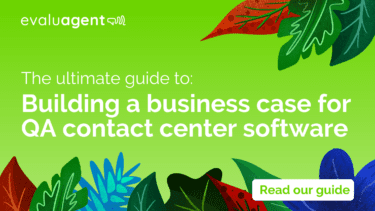The ultimate guide to building a business case for QA contact center software












The contact center has always been a challenging place to work – but today’s contact centers have to deal with more strains than ever. Whether it’s the demands of different customers, the expectations to deliver exceptional service across multiple channels, changing industry regulations or keeping your agents engaged… it’s a lot.
You know this, of course. You also know that technology can help alleviate a lot of these challenges. In fact, Deloitte’s 2023 contact center report shows that modernizing infrastructure and agent-enablement technologies feature as two of the top three investment priorities for the coming year.
And yet, the C-Suite and Board’s priorities will be to tighten the purse strings while confidence in the economy is low. Few will sign off investment into contact center software without being convinced of the benefits it will bring.
We’re going to help you do just that.

Great call center software should help you solve tangible issues within your contact center. With over 25 years of contact center expertise, we’ve found the most contact centers typically experience one or more of the following QA challenges:
Not enough interactions monitored
It’s difficult to make meaningful impact when you’re only sampling 2-5% of interactions. You’ll rarely catch the extremes of the scale with this amount of coverage – both good and bad. It’s these must-monitor interactions that can have the biggest impact in improving customer service.
Upping this number by getting as close to 100% as possible is vital for getting a true picture of your customer experience.
Random sampling of interactions vs over-automation
It’s a catch-22. You randomly sample interactions in the hope of catching at least some of the extremes in customer interactions, which gives you unreliable and inconsistent data. Or, you can leverage automation to find them all – only to drown in data, making it ultimately useless.
The key here is to find software that helps you strike the balance between automation and the human touch.
Using data meaningfully to drive improvement
Senior staff are spending too long sitting behind a screen of data – be it in already existing software, or spreadsheets – instead of coaching and developing their team. They get bogged down in admin, manual workflows and slow reporting.
They could really use real-time, automated workflows that surface important insights quickly and easily. There are tons of different methods and features to not only keep on top of agent development, but make great strides with actionable insights across the contact center.
Engaging agents and teams
With agent attrition rates at a historically high average of 38% and contact center leaders sharing that recruiting and retaining talent is one of their biggest challenges, keeping agents engaged is a big thorn in the side of today’s contact centers.
COVID shook up the norm and changed expectations of working models everywhere, with SQM reporting that 81% of agents prefer to work from home. Not all contact centers are able to offer such flexibility, and the ones that are lack the visibility to engage those who might be ‘quiet quitting’.
Add to that the inevitably high-pressure nature of the job, the lack of recognition and feeling unsupported, it’s no wonder agent attrition continues to climb.
Software can and should promote data transparency, feedback loops and specific agent engagement features like rewards and gamification features.
Identify which of these challenges your call center is facing and start to frame your business case around that. This is not the time for anecdotes or assumptions, so go on a fact-finding mission to uncover the numbers on metrics like:
Do this at a monthly and yearly timescale to start painting a picture of the obstacles you’re facing and, if available, benchmark your data against your industry. This will be essential to making a strong case for software to transform your contact center – as well as identifying which aspects the software should primarily focus on.

Discover how evaluagentCX can help you address the challenges facing contact centers today.
Learn more




Aside from solving core call center challenges, there are lots of other benefits you can look forward to in the best contact center software. Plenty of which will also happen to impress your Board of Directors.
With consumer standards entering the spotlight in financial services, energy, and gaming and gambling, it’s likely other sectors will follow. Regulatory bodies aren’t above naming-and-shaming, as well as delivering fines for non-compliance, so breaches must be taken seriously. Any software worth its salt will feature sophisticated capabilities to help you meet exacting compliance regulations, regardless of your industry.
Look for: redaction, customizable scorecards, automated compliance checks, auto-fail functionality
It’s not enough to rely on post-interaction surveys, which are open to interpretation. Technology has now reached a point where it can automatically detect sentiment through the words used as well as context.
This type of information is ripe for analysis and driving improvement. For example, do you see better sentiment when handling renewals, returns, refunds? Where is it more negative? These are the areas you can then focus on in training and development.
Look for: sentiment analysis, topic detection, audio metrics, customer journey tracking and interaction tagging
While over-automation can leave you wading through data, finding the balance between automation and human oversight opens the door to major time-savings and improvements. The best software will largely automate, but allow plenty of opportunity for human intervention to correct scores, verify information and confirm details before sharing with the team.
Now, you can put your best people to work – using their expertise to drive forward processes and initiatives that will delight both internal teams and customers alike.
Look for: automated work assignments, real-time reporting, a blend of AI and human oversight
This might sound like over-promising, but it’s absolutely possible that the right software provider can make your agents and team leaders happier. And when you really dive into the link between employee experience and the customer experience, there are substantial gains to be made:
When it comes to technology making staff happier, there’s a lot to be said for a beautifully simple interface, understanding the contributions they make and even bringing a little fun into the workplace with leaderboards and healthy competition. Most agents just want their efforts to be recognized, and to have access to support when they need it.
Look for: connected learning management, gamification, coaching scheduling
Is compliance keeping you up at night? Are you drawing a blank when it comes to understanding your customers? Are your agents leaving as fast as they’re joining?
All of these can prove expensive for businesses lacking insight. When writing your business case, lean into the unique benefits software can bring with supporting statistics, industry research, and how these relate to the pain points your contact center suffers with.
Now is also a good time to start identifying some providers that look like they meet your requirements – let’s take a look at that now.

If you’re struggling to uncover insights and issues, it’s time to get your reports and workflows in order.
Take a product tour




It’s a minefield out there. With so many providers to choose from, how do you start to narrow it down? Be specific in your search. ‘Contact center software’ is going to overwhelm you, since you’ll get everything from workforce management to call recording.
Here at evaluagent, we focus specifically on quality assurance and agent improvement, and integrate with a number of other market-leading software providers to give customers the best experience.
So how can you narrow down your options?
When researching a software provider, always take a look at their customer case studies. These usually go through rigorous sign-off processes, so can generally be relied upon for truthful representations of the customer journey. Also consider:
Beyond the provider’s website, it’s also a good idea to check out reviews on external websites, like G2. Here, customers are less obligated to cover up any difficulties. Be on the lookout for:
Doing so will give you an idea of how the software pertains to your business – for example, things that other businesses struggle with may not be a problem for yours.


Most, if not all, platforms will offer an opportunity to demonstrate the software to you, as well as a trial period. Take them up on it! Use the opportunity to ask questions, uncover any limitations of the software, and mine for details of any dealbreakers.
At the end of a demo or trial, note down your key findings, pros and cons – not just about the platform, but the responsiveness of the team, and how satisfied you were overall. This will be crucial when it comes to making your final choice.
Ultimately, the software needs to deliver more benefits than it costs you. Go back to the metrics you compiled at the start of this process – time spent on tasks, agent turnover, customer satisfaction scores – and compare this with the software you’ve seen in action, along with any case studies or additional figures the provider’s able to give you.
You should start to get an understanding of where you’ll make the most gains. One software platform may be cheaper than another, but lacking in a key feature or outcome that matters to you.
At evaluagent, we’ve made calculations based on the average achievements of our customers in their first three months alone:
So not only do our customers make great gains – they do it from the moment they onboard.
Now that you’ve done a lot of research and got to grips with some of the tools you’re considering, it’s time to get down to the granular details.
You’ll need to put any potential providers through their paces with some questions. The most important of which will include:
Naturally, you’ll also want to include anything specific to your organization’s setup, and quiz potential providers on how far the interface can be customized to suit your needs. After all, it needs to scale with your plans for it to be a success.
It’s up to you how you decide to present your research findings in your business case. You may want a table for comparison purposes, or perhaps a page or two dedicated to each platform you’ve considered, with key headlines to help the reader easily scan for the most important points.
Whatever the approach, you just need to demonstrate the thorough lengths you’ve gone to in order to find the best QA platform for your contact center.

Our expert team are on hand to show you how evaluagentCX can help drive your QA processes and agent empowerment forward.
Book a demo




Your business case is now drawing to a conclusion – but there are some final things you’ll want to have assessed before the decision-makers will be open to giving you the green light.
Risk assessment with contact center software works two ways: if you do implement it, and if you don’t.
The risks on implementation typically center around integrations and the platform being able to ‘play nice’ with other technology that you use. If it doesn’t, you’ve not only cost yourself money, but valuable time too.
Another risk could be the level of upskilling required in the team to start using the software at a high-functioning level. If the platform’s interface is overwhelming or puts users off, you’ll find people disengaging and not making the most of the functionality you’ve paid for. It’s a good idea to get team members’ thoughts on different platforms by having them sense-check websites and attend demos to mitigate this.
Of course, there’s also the risk of a platform simply underdelivering. Explain in your business case how you’ll work with the provider’s team to prevent this from happening and set yourself up for the best chance of success.
Worried you’ll make a business case only for it to fall on deaf ears? This is your chance to anticipate all the potential reasons you’ll get a ‘no’ and use evidence to counteract potential pitfalls.
For example, if your metrics are well below industry standard, you need software to help drive efficiency. If software isn’t within budget, the cost could be greater if you’re not able to keep customers happy, or have to spend more resource on recruitment.
There’s also plenty of research available that shows just how heavily many contact centers are investing in technology and cloud-based solutions – hard data and the fear of being left behind can be enough for many Boards to pull the trigger.
Identify what risk looks like to your contact center, have a plan for mitigation, and show that you’ve considered all angles.
Let’s say you’ve a platform in mind and it looks like it’s ticking all the boxes. That’s brilliant – for right now. But many Boards and Directors aren’t just thinking about the now, they need to see consideration for the future too, since this will influence many of their spending decisions.
If your preferred partner is able to share their product roadmap with you, or demonstrate how they use customer feedback to directly develop their platform, that will pay dividends when it comes to showing how the platform will grow with you. It’s all about showing how this isn’t just implementing some technology, but also making the goals of the contact center – and wider business – a reality.
Naturally, we’ll be the first to say that price shouldn’t be the defining factor of your decision-making, but it will be crucial in helping you calculate that all-important return on investment we covered earlier.
Knowing the software provider’s pricing structure and terms is the minimum information a Board will expect to see. But also ask about additional costs – like certain features behind paywalls, account management, or how user numbers affect costs.
Weigh up what matters most to you. Do you need hands-on management? Want flexibility in active accounts? Are those market-leading features within your budget – and will they make the difference a year from now?
It’s a good idea to have a general budget in mind of what you think is realistic to get signed off. But don’t be afraid to put forward the solution you think best matches your needs even if it’s a little higher. A compelling business case can make all the difference!





Now it’s decision time. The reality is this might be the only section Senior Management has time to read, so don’t run out of steam now.
Put forward your vendor of choice, succinctly summarizing the following:
Ideally, this should take up no more than one page. If the reader wants more details, well, you’ve already covered a lot of it in previous sections. In fact, these bullet points should easily relate to the main sections of your business case – simply refer to the specific page in case the reader should want to comb over a specific area in greater depth.





Every engagement counts when it comes to understanding, elevating, and differentiating the Customer Experience (CX).
evaluagentCX helps you deliver outstanding customer experiences by automating agent improvement. The platform analyzes 100% of interactions – from calls and emails, to web chats, tickets, and social media. No stone is left unturned, giving you actionable insights to share with your organization and the ability to laser-focus QA efforts on must-monitor interactions and agent development.
We help businesses worldwide to:
Think of evaluagent as your AI-powered QA co-pilot. Leverage intelligence from every interaction to understand, elevate and differentiate your customer experience at scale – all while never forgetting the value of the human touch.






